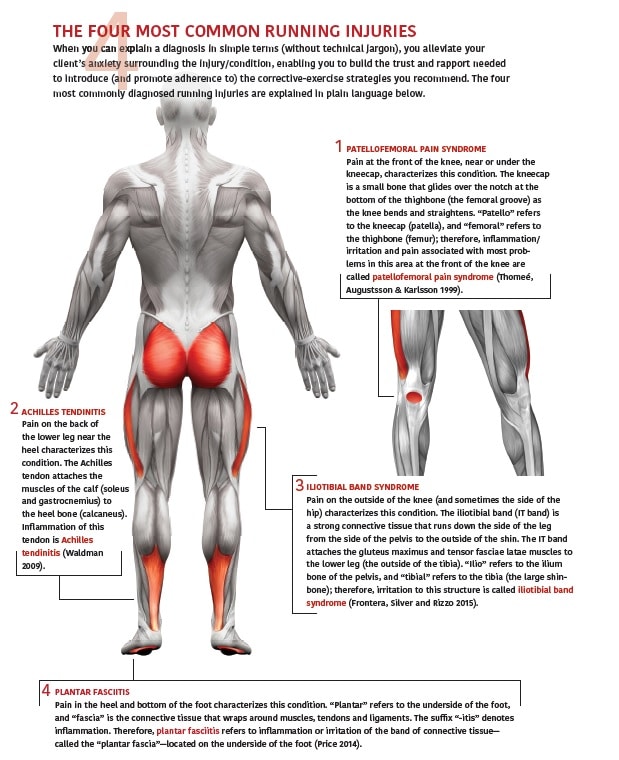
The four lower-body injuries runners experience most often are plantar fasciitis, Achilles tendinitis, patellofemoral syndrome (“runner’s knee”) and iliotibial (IT) band syndrome (Hespanhol et al. 2011). These common injuries result from musculoskeletal and movement imbalances compounded by overuse.
While it is not within your scope of practice as a fitness professional to confirm or diagnose medical conditions, it is important to have a basic understanding of common running injuries, because it helps you communicate effectively with clients about their diagnoses. Master your role in addressing the musculoskeletal and movement imbalances underlying clients’ problems by educating yourself about the most common injuries and how to use corrective-exercise techniques to address them.
Basic Biomechanics
When we run, the body moves in all three planes of motion (i.e., from side to side, in rotation, and forward and backward). Side-to-side movements enable us to take alternating steps from left to right, which helps propel us forward or backward. As we move our legs forward or backward, we also swing our arms forward and backward, which creates rotation in the torso, thus enabling the spine, hips and legs to move. This movement combination helps us temporarily overcome gravity in order to complete an activity. However, these movements also help us absorb shock, or ground reaction forces, by allowing the body to move in the direction of impact, which is opposite to the direction of the pull of gravity.
In addition to movement, the body has other strategies for dealing with gravity and ground reaction forces. Soft-tissue structures (especially our muscles) dissipate energy as impact travels back up the body (Ayyappa 1997). When a person is running, for example, certain muscles contract to swing the leg forward. As the foot strikes the ground and the body has to deal with impact, the muscles of the foot, ankle and leg lengthen under tension. The muscle tension helps the body absorb shock and creates energy for subsequent movements.
If muscles are not healthy, flexible and strong, they are less effective at transferring weight and absorbing shock. As a result, other soft tissues in the body—such as fascia, tendons and ligaments—must work harder. Over time, these structures become overworked, stressed and strained, leading to injury, pain and further dysfunction.
Similarly, if muscles aren’t working correctly the joints can become inflamed or can lack range of motion. Movements then become restricted and the body becomes less effective at dissipating gravity, absorbing shock and creating energy for movement.
The Four Most Common Running Injuries

